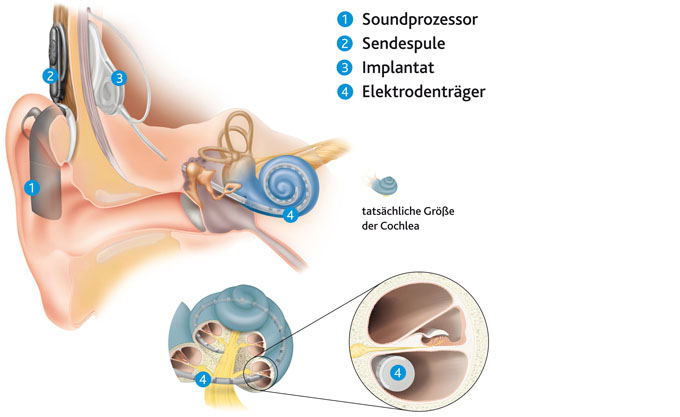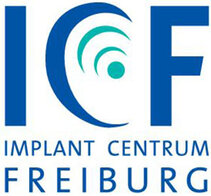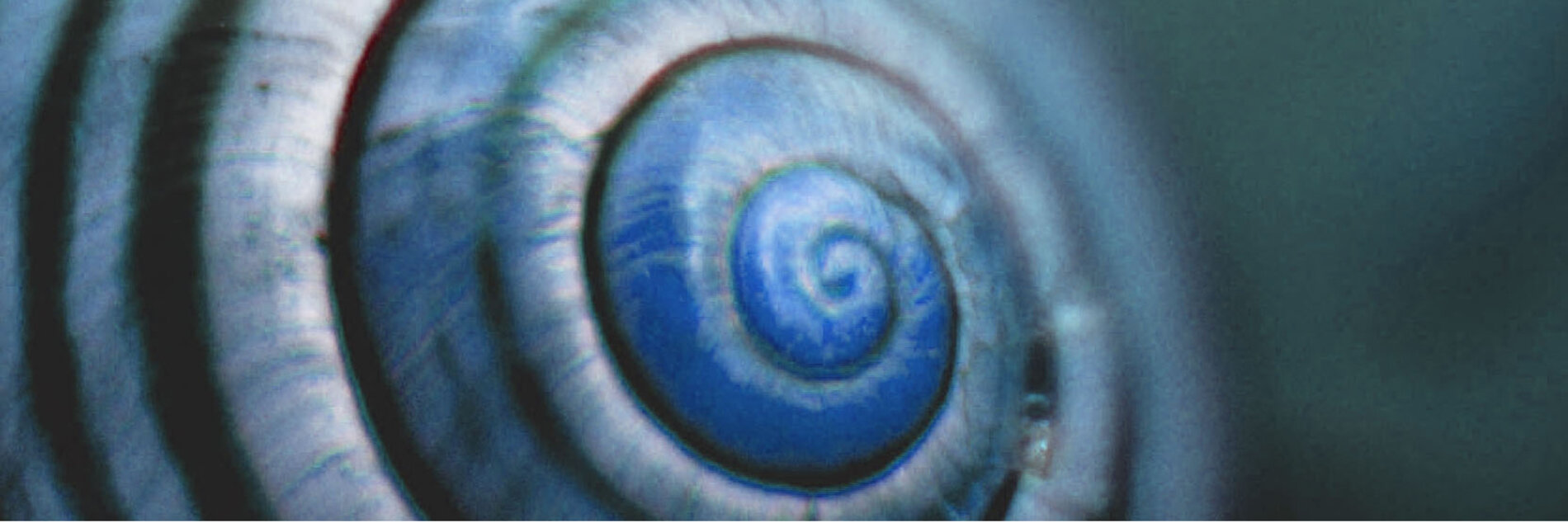Cochlear Implant
Cochlear Implant Centrum Freiburg - ICFThe cochlear implant is unique in medical technology, in that it can replace a human sensory organ. The CI attempts to replace the function of the inner ear in people with hearing loss near deafness or high-grade hearing loss that does not enable sufficient speech recognition, but whose auditory nerve is functional.
How the cochlear implant functions

Copyright Cochlear Limited
The cochlear implant consists of two parts: The implant, which is inserted surgically under the skin behind the ear, and the sound processor, which is worn externally behind the ear. In the sound processor, sound signals received via the microphone are transformed into electrical signals. These coded impulses are conducted to the transmitter coil, which is held by magnetic force over the implanted receptor coil. The electrical impulses are sent as radio waves through the scalp to the implant, which decodes the signals and transmits them to the electrode frame in the cochlea. The intact auditory nerve is stimulated via the electrodes and the information transmitted to the brain via the auditory path for processing and interpretation.
Indication for a cochlear implant
This operation is indicated when high-grade or near-deafness hearing impairment is present. Since such hearing impairment is usually due to limited inner-ear function, the cochlear implant attempts to replace the inner-ear function.
In high-grade hearing loss, both ears may be affected or only one ear. The hearing in the other ear may be either normal (single-sided deafness) – or there is deafness of a different degree and the ear is fitted with a hearing aid (bimodal treatment).
Another indication is given when only the high-tone range is affected by the high-grade hearing loss, but the low-tone range in the same ear is still good enough to be treated with a hearing aid (electro-acoustic stimulation or hybrid treatment).
- Duration of deafness
Children who are deaf or suffer high-grade hearing loss, who become deaf before or during speech acquisition and do not develop adequate speech despite optimal provision of hearing aids, are supplied with a CI optimally prior to their first birthday. Neurophysiology assumes that the first three years of life are decisive for the development of speech. There is no later catching up of this sensitive phase, which is critical for auditory learning and speech acquisition. The duration of deafness is thus generally a decisive factor in considering the expected success of implantation. Exceptions are children, adolescents and adults in whom deafness has increased over the years and who were optimally supplied with hearing aids during that early phase. In children born with single-sided deafness, implantation is usually recommended up to the age of 4. Even adolescents and adults who were born deaf may profit from implantation, as long as the expectations corresponding to development possibilities are worked out and made clear to them prior to surgery.
Fitting with a Cochlear Implant
The patient cannot hear after the operation of the receiver unit! Usually, it takes 4 weeks for the cochlear implant to heal in. Only then can one start to adjust the technology to the individual physiological situation via the transmitter (the externally-worn sound processor).
In exceptional cases, for example in acute deafness in both ears, temporary fitting, a so-called early fitting, is already undertaken in the week after the implantation.
The setting of the individual parameters depends, among other things, on the position of the electrodes, the formation of connective tissue around the electrode frame, the number of functional nerve fibers. The individual electrodes on the electrode frame located in the inner ear must be so set that they stimulate the auditory nerve, without causing over-stimulation or under-stimulation.
Many adjustments are necessary in the initial period after implantation before the system is appropriately adjusted to fit the individual physiological situation. During the later course, readjustment must be made at least once a year. CI patients require follow-up care for the rest of their lives. Intensive post-surgical care is decisive to the success of an implantation, and precise adaptation of the sound processor is one of the essential requisites.
- Special Adaptation Situation in Children
The fitting of children up to age 6 and of children with multiple handicaps or behavioral problems is assisted by speecj therapy. The speech therapist motivates and supports the child during the (learning) phases of fitting: observation of behavior during the initial fitting, distraction and game audiometry during subsequent fitting and practicing of the multi-level scaling during the further fitting process. During a fitting, the sound processor is connected to an adaptor unit. The child can hear nothing of the environment in this situation. As soon as the technician applies a stimulus via the CI, the speech therapist hears an acoustic signal from a loudspeaker at the same time, making it better possible to determine whether a reaction, if any, by the child correlates with the applied stimulus. A behavior observation is conducted for small children. The children show a wide variety of recognizable reactions to the perceived stimulus: they stop, turn towards their parents, increase the sucking rate, often changes in mimicry are observed as soon as the children perceive something. In children born deaf, only very discrete reactions can be observed in the eyes or mimicry. If there is clear hearing reaction, the children are conditioned by an electrical stimulus to turn their gaze to a computer monitor on which a child-appropriate image is presented (audio-visual-synchronized stimuli, distraction audiometry). Older children can indicate very precisely when they have hearing perception by performing a motion which they have learned and practiced (game audiometry). - ECAP-Measurements (NRT by Cochlear Ltd., NRI by AB, ART by MedEl)
An important aid in fitting is the measurement of auditory nerve response. During this measurement, which is usually performed with the patient’s own sound processor, the collective response of all neurons in the stimulation field is recorded (electrically-evoked compound action potential = ECAP). The ECAP measurement can be performed without cooperation from the child. Since the responses usually arise only with clearly perceptible signals, the child must be carefully observed during the measurement. Too-loud stimulation and traumatization of the child must be avoided by careful selection of measuring parameters and precise observation of behavior. The usability of the auditory nerve responses varies widely from manufacturer to manufacturer. The results of the postoperative Advanced NRT measurement from Cochlear Ltd. correspond in most cases to the profile of adjustment values over the electrode array, and correlate in most cases with the values of maximum comfort. This applies with greater reservations for the NRI measurements from Advanced Bionics as well. The results of the ART measurement from MedEl are distributed over the electrode array mostly between the perception threshold and the threshold of maximal comfort. - Signal Preprocessing Strategies
These days, all manufacturers offer preprocessing strategies, which are intended to simplify hearing (learning) with the CI. The natural process of suppression of disruptive noise does not function, among other things because the brain cannot act directly back on the CI technology. Signal preprocessing improves hearing and speech recognition in defined situations, for example speech in quiet, speech in disruptive noise, soft tone events in quiet situations, disruptive noise situations, wind sounds, music. - Coupling Possibilities
The sound processors of the various manufacturers have built-in induction coils (so-called telephone coils). These induction coils can usually be activated with the appropriate remote control, when there is a notice that corresponding ring loops are installed in cinemas, churches, lecture rooms, offices or other public facilities. The induction coil in the single-unit processor Kanso from Cochlear Ltd. does not work in connection with a CI6xx implant.
Some sound processors have audio input, such as the CP910 from Cochlear Ltd. and the Sonnet2 from MedEl (here via an extra battery case), through which a direct cable connection can be made to replication units. In the case of the Naida CI Q90 from Advanced Bionics, an audio-cable connection can be made indirectly via the streamer, the compilot, by coupling the replication unit with the compilot. The same applies to the CP1000; here, too, an audio-cable connection can be made indirectly via the Minimic2. For Med El and Oticon there is additionally a cable-connected indirect possibility via an iLoop.
All manufacturers offer system-integrated FM systems:

FM-receivers can moreover be connected to the Minimic2 and enable transmission to the CP950 (Kanso, Cochlear Ltd.). In the case of the Rondo2 (Med El), the FM receiver can be connected via a linked extra battery component. Moreover, an FM receiver can be connected to the Compilot (Advanced Bionics).
All manufacturers offer wireless digital transmission by Bluetooth:
In the CP910/920/CP950, the wireless digital transmission is made via a Minimic2 and/or an audiostreamer coupled with the corresponding replication unit, or via a telephone clip which can be coupled to a mobile phone.
With the CP1000 from Cochlear Ltd., a direct wireless connection is possible to an iPhone (IOS) or smartphone (Android).
The Sonnet 2 from Med El can also be coupled directly to a mobile phone and controlled with the mobile. The telephone transmission (mobile) is made via the audiolink to Sonnet2 especially since the audiolink serves as the microphone during the telephone call.
The Neuro 2 from Oticon can likewise be coupled directly with the mobile and controlled with the mobile or via the Streamer XM, through which the mobile transmission to the Neuro 2 is made.
For the Naida CI Q90, a direct connection to the mobile goes via the CI-Connect, which is plugged into the 170er-rechareable battery. The CI-Connect has an integrated microphone so that telephoning is possible here without having to bring the mobile close to the ear or mouth.
Since only the connection to the sound processor to which the CI-Connect is plugged is possible, a wireless transmission to Bluetooth-compatible equipment is possible to both sides (CI and CI/or HG) with the Compilot hung around the neck.
Moreover, Advanced Bionics offers a DECT-Telephone that can be coupled directly with the Naida CI Q90.

Implant Centrum Freiburg - ICF
Elsässerstrasse 2n
79110 Freiburg
Telephone: 49 (0)761 - 270 72920 / 72810
Telefax: 49 (0)761 - 270 72780
You can reach us by telephone
- Tuesdays from 8.30 a.m. to 3.30 p.m.
- Wednesdays from 1.30 p.m. to 3.30 p.m.
- Thursdays from 1.30 p.m. to 3.30 p.m.
In emergencies, you can reach us by telephone
- Mondays from 1.30 p.m. to 3.30 p.m.
- Fridays from 8.00 a.m. to 12.30 p.m.

